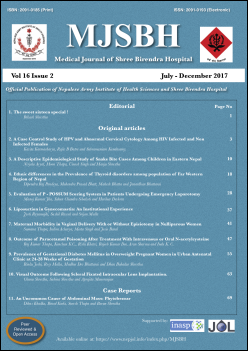Prevalance of Gestational Diabetes Mellitus in Overweight Pregnant Women in Urban Antenatal Clinic at 24-28 Weeks of Gestation
Keywords:
Gestational diabetes, overweight, pregnancy, NepalAbstract
Introduction: Diabetes has become a significant health problem all over the world and its prevalence is increasing rapidly, including in Nepal. Prevalence of gestational diabetes mellitus (GDM) is directly related to the prevalence of type 2 diabetes. Women who areoverweight or obese before they become pregnant are more at risk of GDM irrespective of other factors.Though the risk of developing GDM in shown to be higher in overweight or obese women, there are very few studies done to show such observation in the urban population of Nepal.
Methods: This was a hospital based cross-sectional prospective study conducted among the women attending ante partum clinic, in a tertiary level hospital, located at Lalitpur for one-year duration in 2009. All overweight (pre-pregnancy body mass index (BMI)>23) urban women at 24-28 weeks of gestation were enrolled.Fasting blood glucose, screening 50-g oral glucose challenge test(OGTT) and 2-hr OGTT following overnight fastingwas done as per need based on their test results and GDM was diagnosed based on standard guidelines.
Results: Out of 256 women majority of women had BMI >25 kg/m2 (n=180),and 151(59%) were multiparous and 105 (41%) were primiparas. Positive screening test was obtained in 51 women (19.9%).The incidence of GDM by ADA and WHO criteria was 10 (3.9%) and 16 (6.3%) respectively. There was statistically non-significant difference in the rate of positive screening test and BMI (p=0.09). The abnormal screening test between primiparous and multiparous was significant (p=0.01).
Conclusion: This study showed a high pre-pregnancy BMI and the incidence of GDMamong the patients enrolled. The rate of positive screening test is also higher than the previous studies so, GDM is a growing issue and must be well addressed.
Downloads
Downloads
Published
How to Cite
Issue
Section
License
This license enables reusers to distribute, remix, adapt, and build upon the material in any medium or format for noncommercial purposes only, and only so long as attribution is given to the creator.




